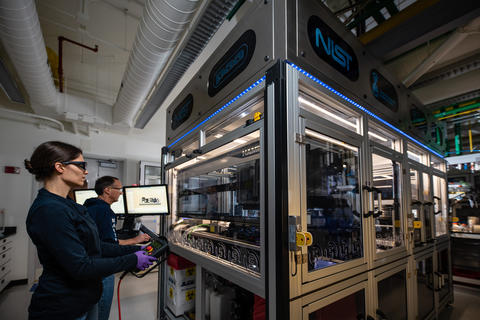Advancing trust in measurement and technology in service to the nation

Imagine a world where measurements are precise, data flows securely, and materials push the boundaries of possibility. This is the reality we create with our dedicated minds and cutting-edge programs at the National Institute of Standards and Technology (NIST).
NIST has labs that focus on different kinds of measurements—from physical things like pressure and humidity to those necessary for information and communication technology. We also have programs that connect our research to industry.
The people of NIST—including five Nobel Prize winners—have been at the forefront of scientific exploration for more than 120 years. That groundbreaking research happens in our labs.
In addition to managing grant programs, the Associate Director for Laboratory Programs (ADLP) oversees NIST’s six labs:
- NIST Center for Neutron Research (NCNR): Neutrons are unseen giants that reveal the inner workings of materials. NCNR provides researchers with this powerful probe, unlocking secrets of new technologies like biopharmaceuticals or advanced electronics.
- Material Measurement Laboratory (MML): MML develops methods to understand and predict material behavior, pushing the limits of performance and safety.
- Communications Technology Laboratory (CTL): CTL advances the measurement science behind wireless technologies in computer chips, antennas and more. Their work means higher speeds, better connections and broader access for everyone’s wireless devices.
- Physical Measurement Laboratory (PML): PML defines the scales that underpin science and industry. Whether it’s the weight of a feather to the speed of light, they ensure accuracy and trust in every measurement.
- Engineering Laboratory (EL): EL safeguards lives and infrastructure. They test, analyze and innovate, helping to make buildings earthquake-resistant and fabrics safe from fires.
- Information Technology Laboratory (ITL): ITL champions cybersecurity, data privacy and artificial intelligence trustworthiness. They craft standards, tools and best practices to navigate the ever-evolving digital landscape.
The ADLP also manages several offices and programs within NIST that play an important role in our research and beyond our labs:
- The Special Programs Office forges partnerships among government, academia, professional organizations and industry to provide standards and technology leadership. SPO focuses on advancing research in forensic science, measuring greenhouse gases and promoting open data.
- The Standards Coordination Office (SCO) offers resources to help businesses, government agencies and standards bodies navigate the complex world of standards and conformity assessment.
- The Research Data and Computing Office collaborates with research teams to facilitate adoption of standards and best practice for data science and computing.
- The Research Protections Office ensures our research follows all ethical principles.
- The National Voluntary Laboratory Accreditation Program (NVLAP): Ensuring quality and trust, NVLAP sets the gold standard for testing and calibration labs across diverse industries.
Associate Director, Laboratory Programs

Dr. S. Shyam Sunder is the Associate Director for Laboratory Programs (ADLP), the purpose of which is to promote U.S. innovation and international competitiveness with a focus on unleashing American innovation. As ADLP, he provides strategic direction and operational guidance for all of NIST's scientific and technical laboratory programs.










